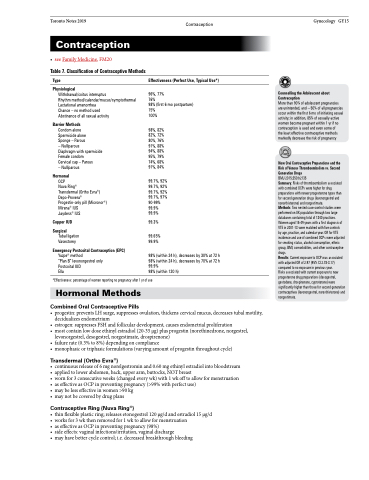Page 501 - TNFlipTest
P. 501
Toronto Notes 2019
Contraception
Gynecology GY15
Contraception
• seeFamilyMedicine,FM20
Table 7. Classification of Contraceptive Methods
Type Physiological
Withdrawal/coitus interruptus
Rhythm method/calendar/mucus/symptothermal Lactational amenorrhea
Chance – no method used
Abstinence of all sexual activity
Barrier Methods
Condom alone
Spermicide alone
Sponge – Parous
– Nulliparous
Diaphragm with spermicide Female condom
Cervical cap – Parous – Nulliparous
Hormonal
OCP
Nuva Ring®
Transdermal (Ortho Evra®) Depo-Provera®
Progestin-only pill (Micronor®) Mirena® IUS
Jaydess® IUS
Copper IUD
Surgical
Tubal ligation Vasectomy
Emergency Postcoital Contraception (EPC)
Yuzpe® method
“Plan B” levonorgestrel only Postcoital IUD
Ella
Effectiveness (Perfect Use, Typical Use*)
96%, 77% 76%
98% (first 6 15%
100%
98%, 82% 82%, 72% 80%, 76% 91%, 88% 94%, 88% 95%, 79% 74%, 68% 91%, 84%
99.7%, 92% 99.7%, 92% 99.7%, 92% 99.7%, 97% 90-99% 99.9% 99.9%
99.3%
99.65% 99.9%
98% (within 98% (within 99.9%
98% (within
mo postpartum)
Counselling the Adolescent about Contraception
More than 90% of adolescent pregnancies are unintended, and ~50% of all pregnancies occur within the first 6 mo of initiating sexual activity; in addition, 85% of sexually active women become pregnant within 1 yr if no contraception is used and even some of
the least effective contraceptive methods markedly decrease the risk of pregnancy
New Oral Contraceptive Preparations and the Risk of Venous Thromboembolism vs. Second Generation Drugs
BMJ 2015;350:h2135
Summary: Risks of thromboembolism associated with combined OCPs were higher for drug preparations with newer progesterone types than for second generation drugs (levonorgestrel and noresthisterone) and norgestimate.
Methods: Two nested case-control studies were performed on UK population through two large databases containing total of 1340 practices. Women aged 15-49 years with a first diagnosis of VTE in 2001-13 were matched with five controls
by age, practice, and calendar year. OR for VTE incidence and use of combined OCPs were adjusted for smoking status, alcohol consumption, ethnic group, BMI, comorbidities, and other contraceptive drugs.
Results: Current exposure to OCP was associated with adjusted OR of 2.97 (95% CI 2.78-3.17) compared to no exposure in previous year.
Risks associated with current exposure to new progesterone drug preparations (desogestrel, gestodene, drospirenone, cyproterone) were significantly higher than those for second generation contraceptives (levonorgestrel, noresthisterone) and norgestimate.
24 h), decreases by 30% at 72 h 24 h), decreases by 70% at 72 h
120 h)
*Effectiveness: percentage of women reporting no pregnancy after 1 yr of use
Hormonal Methods
Combined Oral Contraceptive Pills
• progestin:preventsLHsurge,suppressesovulation,thickenscervicalmucus,decreasestubalmotility, decidualizes endometrium
• estrogen:suppressesFSHandfolliculardevelopment,causesendometrialproliferation
• mostcontainlowdoseethinylestradiol(20-35μg)plusprogestin(norethinedrone,norgestrel,
levonorgestrel, desogestrel, norgestimate, drospirenone)
• failurerate(0.3%to8%)dependingoncompliance
• monophasicortriphasicformulations(varyingamountofprogestinthroughoutcycle)
Transdermal (Ortho Evra®)
• continuousreleaseof6mgnorelgestrominand0.60mgethinylestradiolintobloodstream • appliedtolowerabdomen,back,upperarm,buttocks,NOTbreast
• wornfor3consecutiveweeks(changedeverywk)with1wkofftoallowformenstruation • aseffectiveasOCPinpreventingpregnancy(>99%withperfectuse)
• maybelesseffectiveinwomen>90kg • maynotbecoveredbydrugplans
Contraceptive Ring (Nuva Ring®)
• thinflexibleplasticring;releasesetonogestrel120μg/dandestradiol15μg/d • worksfor3wkthenremovedfor1wktoallowformenstruation
• aseffectiveasOCPinpreventingpregnancy(98%)
• sideeffects:vaginalinfections/irritation,vaginaldischarge
• mayhavebettercyclecontrol;i.e.decreasedbreakthroughbleeding


